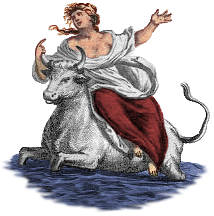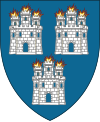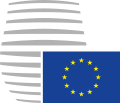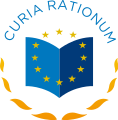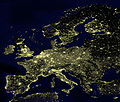Portal:European Union
Introduction
The European Union (EU) is a supranational political and economic union of 27 member states that are located primarily in Europe. The Union has a total area of 4,233,255 km2 (1,634,469 sq mi) and an estimated total population of over 448 million. The EU has often been described as a sui generis political entity (without precedent or comparison) combining the characteristics of both a federation and a confederation. Containing 5.8% of the world population in 2020, EU member states generated a nominal gross domestic product (GDP) of around US$16.6 trillion in 2022, constituting approximately one sixth of global nominal GDP. Additionally, all EU states except Bulgaria have a very high Human Development Index according to the United Nations Development Programme. Its cornerstone, the Customs Union, paved the way to establishing an internal single market based on standardised legal framework and legislation that applies in all member states in those matters, and only those matters, where the states have agreed to act as one. EU policies aim to ensure the free movement of people, goods, services and capital within the internal market; enact legislation in justice and home affairs; and maintain common policies on trade, agriculture, fisheries and regional development. Passport controls have been abolished for travel within the Schengen Area. The eurozone is a group composed of the 20 EU member states that have fully implemented the economic and monetary union and use the euro currency. Through the Common Foreign and Security Policy, the union has developed a role in external relations and defence. It maintains permanent diplomatic missions throughout the world and represents itself at the United Nations, the World Trade Organization, the G7 and the G20. Due to its global influence, the European Union has been described by some scholars as an emerging superpower. In 2012, the EU was awarded the Nobel Peace Prize. The United Kingdom became the only member state to leave the EU, in 2020; ten countries are aspiring or negotiating to join it. (Full article...) Selected article The Treaty of Lisbon or Lisbon Treaty (initially known as the Reform Treaty) is an international agreement which amends the two treaties which form the constitutional basis of the European Union (EU). The Lisbon Treaty was signed by the EU member states on 13 December 2007, and entered into force on 1 December 2009. It amends the Maastricht Treaty (also known as the Treaty on European Union) and the Treaty establishing the European Community (TEC; also known as the Treaty of Rome). In this process, the Rome Treaty was renamed to the Treaty on the Functioning of the European Union (TFEU). Prominent changes included the move from unanimity to qualified majority voting in several policy areas in the Council of Ministers, a change in calculating such a majority to a new double majority, a more powerful European Parliament forming a bicameral legislature alongside the Council of ministers under the ordinary legislative procedure, a consolidated legal personality for the EU and the creation of a long-term President of the European Council and a High Representative of the Union for Foreign Affairs and Security Policy. The Treaty also made the Union's bill of rights, the Charter of Fundamental Rights, legally binding. Selected picturePainting: František Kupka The Cathedral is an abstract oil painting on canvas created by Czech artist František Kupka in 1912–1913. Measuring 180 by 150 centimetres (71 in × 59 in), the painting is held by the Museum Kampa in Prague, Czech Republic. In this painting, vertical lines running the entire length of the canvas are intersected by diagonal lines to form rectilinear shapes of various sizes and colors.
Did you know?...that Romania and Bulgaria became full members of the European Union on January 1, 2007? ...that the European Union's member states combined represent the world's largest economy by GDP, larger than the United States, the People's Republic of China, and Japan, the seventh largest territory in the world by area and the third largest by population after China and India? Selected cityDublin is the capital and the largest city of the Republic of Ireland, located near the midpoint of Ireland's east coast, at the mouth of the River Liffey and forms the centre of the Dublin Region. Originally founded as a centre of Viking settlement, the city has been Ireland's capital city since mediæval times. The population within the city was 505,739 at the census of 2006. Beyond this, at the same census the Dublin Region population was 1,186,159, whilst the Greater Dublin Area had a figure of 1,661,185. In a 2003 European wide survey by the BBC, questioning 11,200 residents of 112 urban and rural areas, Dublin was found to be the best capital city in Europe to live in, and the Republic of Ireland was judged to be the most content country in Europe. A person from Dublin is known as a Dubliner or colloquially as a Dub. Dublin is a major European cultural centre and the origin of many prominent literary figures including Jonathan Swift, Bram Stoker, Oscar Wilde, William Butler Yeats, James Joyce, George Bernard Shaw, Seán O'Casey, and Samuel Beckett. General imagesThe following are images from various European Union-related articles on Wikipedia.
TopicsFeatured contentFeatured articles
Featured lists
Featured contentGood articles
CategoriesRelated portalsAssociated WikimediaThe following Wikimedia Foundation sister projects provide more on this subject:
Discover Wikipedia using portals |



